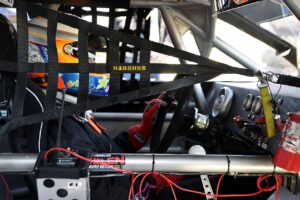No products in the cart.
Fun Facts
Inside the War Room: A Look at NASCAR Race Control
 Inside the War Room: A Look at NASCAR Race Control
Inside the War Room: A Look at NASCAR Race Control
The roar of engines, the blur of speeding cars, the electrifying energy of the crowd – these are the hallmarks of a NASCAR race. But beneath the surface, another battle unfolds in a high-pressure environment known as Race Control. This is the central nervous system of the race, where officials make split-second decisions, monitor every movement on the track, and ensure a safe and competitive event.
Imagine a room filled with a sea of monitors displaying live feeds from various points around the track. Spotters with eagle eyes scan every corner, radios crackle with communication, and experienced officials analyze data in real-time. This is the heart of Race Control, where a dedicated team works tirelessly to oversee every aspect of the race.
The Crew at the Helm
The Race Control team is a diverse group of individuals, each bringing a unique skillset to the table. Here’s a look at some key players:
- Race Director: The ultimate authority figure, the Race Director oversees the entire race. They make crucial calls on penalties, caution flags, and race stoppages.
- Assistant Race Directors: These individuals support the Race Director, focusing on specific areas like officiating restarts, monitoring weather conditions, and communicating with spotters.
- Spotters: These are the eyes in the sky, positioned high above the track. They communicate vital information to drivers, such as potential hazards and car positions.
- Scoring Officials: These individuals meticulously track every lap time, position change, and pit stop, ensuring the accuracy of the race leaderboard.
- Technical Officials: This team monitors car performance data, ensuring compliance with race regulations and investigating potential infractions.
Technology: The Eyes and Ears of the Race
Modern Race Control relies heavily on sophisticated technology to monitor the race with incredible precision. Here are some of the crucial tools utilized:
- Live Video Feeds: A network of cameras strategically placed around the track provides a 360-degree view of the action, allowing officials to observe every corner and incident.
- In-Car Cameras and Audio: Cameras mounted within cars provide valuable insights into driver actions and potential violations. Audio communication between drivers and crew chiefs is also monitored.
- Real-Time Data Analysis: Sophisticated software analyzes car telemetry data, tracking lap times, tire wear, and engine performance, helping officials identify potential issues and enforce regulations.
- Looping and Replay Systems: Advanced systems allow Race Control to rewind and replay specific incidents from multiple angles, ensuring accurate decision-making regarding penalties or race stoppages.
The Art of the Call: Balancing Safety and Competition
Race Control officials walk a tightrope, balancing safety concerns with the need for a competitive race. Here’s what goes into their crucial decisions:
- Accident Prevention: Safety is paramount. A primary responsibility of Race Control is to identify potential accidents or dangerous situations and deploy caution flags to slow the field down and ensure driver safety.
- Enforcing Rules: Officials enforce race regulations, ranging from exceeding pit road speed limits to making illegal maneuvers. Penalties can range from warnings to black flags and driver disqualifications.
- Maintaining Fair Play: Race Control ensures a level playing field for all participants. They analyze driver behavior to identify potential blocking or aggressive maneuvers that could give one driver an unfair advantage.
- Adapting to the Unexpected: Race Control officials need to be prepared for anything. From sudden weather changes to unforeseen accidents, they must assess situations quickly and make real-time decisions to keep the race running smoothly.
The Pressure Cooker: Making Split-Second Decisions
NASCAR races are a whirlwind of activity, with decisions often needing to be made within seconds. This high-pressure environment demands unwavering focus and clear communication from the Race Control team.
- Clear Communication Protocols: Established communication protocols ensure seamless information flow. Spotters relay information to their drivers, who in turn communicate with crew chiefs. Meanwhile, Race Control officials share updates with each other and broadcasting teams.
- Experience Under Fire: The officials in Race Control are seasoned professionals. They undergo rigorous training and have years of experience dealing with pressure situations. This allows them to remain calm and collected under fire, making critical decisions with clarity and precision.
- The Human Touch: While technology plays a crucial role, the human element remains vital. Officials rely on their experience and intuition to interpret data and make judgment calls in complex situations.
A Look Beyond the Finish Line
The work of Race Control doesn’t end with the checkered flag. Officials review race data post-race, analyzing incidents, and potentially issuing additional penalties if necessary. They also work collaboratively with teams to ensure the continuous improvement of race regulations and safety protocols.



